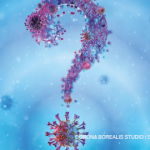Note to reader: As our understanding of COVID-19 evolves, some of the information in the article below, which was current at the time the article went to press, may have changed in the interim.
 Patients and healthcare providers around the world are working hard to meet the challenges posed by the COVID-19 pandemic, in which more than 2 million individuals have been infected with the highly virulent SARS-CoV-2 virus.1 This new and evolving problem has prompted many important questions to be asked within the rheumatology community, particularly with respect to preventing infection in patients with autoimmune diseases, many of whom are being treated with immunosuppressants.
Patients and healthcare providers around the world are working hard to meet the challenges posed by the COVID-19 pandemic, in which more than 2 million individuals have been infected with the highly virulent SARS-CoV-2 virus.1 This new and evolving problem has prompted many important questions to be asked within the rheumatology community, particularly with respect to preventing infection in patients with autoimmune diseases, many of whom are being treated with immunosuppressants.
Advice for Patients
In late April, the Centers for Disease Control and Prevention (CDC) released an updated list of symptoms to watch for. Cassandra Calabrese, DO, a physician in the Department of Rheumatic and Immunologic Diseases, Cleveland Clinic, and a graduate of the combined rheumatology and infectious disease training program at Cleveland Clinic, notes the importance of social distancing and other preventive measures to decrease the spread of infection cannot be overstated.
Providers should counsel patients to stay out of public places and to work from home, practice excellent hand hygiene, resist touching the face as much as possible and follow all other recommendations disseminated by the CDC.2
It would be prudent to advise exposed patients to quarantine for 14 days & closely monitor for symptoms of infection, such as fever, cough & shortness of breath.
Dr. Calabrese notes it is not yet known whether patients with autoimmune diseases or those on immunosuppressive medications, such as conventional synthetic and biologic disease-modifying anti-rheumatic drugs (csDMARDs and bDMARDs), are at increased risk of COVID-19 or of more severe disease if infected. However, the COVID-19 Global Rheumatology Alliance is collecting data to answer these questions via several online registries for providers, and adult and pediatric patients with rheumatic conditions to document their experiences and outcomes with SARS-CoV-2 infection.3
Many patients are asking their rheumatologist what to do if they are exposed to someone with COVID-19. Dr. Calabrese points out that, although the level of risk associated with the exposure does make a difference (i.e., interacting for a few minutes at a distance with a COVID-19-positive individual vs. living with or working in close contact and over extended periods with COVID-19-positive individuals), it would be prudent to advise exposed patients to quarantine for 14 days and closely monitor for symptoms of infection, such as fever, cough and shortness of breath.
The availability of testing may vary by region and is changing over time. Thus, patients need to discuss advice on testing with their rheumatologist if they are concerned they have been exposed. This may have implications on decisions to temporarily hold treatment with immunosuppressants.
Clinical Guidance
Kevin Winthrop, MD, MPH, professor of infectious diseases, public health and preventive medicine, and ophthalmology at Oregon Health and Science University, Portland, served as a member of the ACR COVID-19 Clinical Guidance Task Force, which released clinical guidance for practitioners caring for patients with rheumatic disease. The purpose of this guidance is to help rheumatologists and other providers manage adult patients safely and effectively in the midst of the COVID-19 pandemic.
Using a modified Delphi process and a rating system of low, moderate and high in terms of consensus, the task force—comprising 10 rheumatologists and four infectious disease specialists—created a set of recommendation statements to help guide clinical decision-making in different situations.
The document includes recommendations for the ongoing treatment of stable adult patients in the absence of SARS-CoV-2 exposure or infection, in the presence of exposure and in the context of presumptive or diagnosed SARS-CoV-2 infection, as well as treatment of newly diagnosed or active rheumatic disease.4 For example, one recommendation is that, for all patients, regardless of exposure or infection status, glucocorticoids, if indicated, should be used at the lowest dose and for the shortest duration necessary. The guidance stresses that uninfected patients should not stop their DMARDs preventively if they are benefitting from them. Dr. Winthrop explains, “We favor maintaining disease control over stopping medications preventively and risking a flare of the underlying rheumatologic disease.”
Dr. Winthrop points out this guidance is meant to assist in clinical decision making, must involve case-by-case discussion between the physician and patient, and should be viewed in the context of new and evolving data on COVID-19.
Medications
On the subject of holding medications, the topic of ibuprofen has created quite a bit of potential confusion. In a letter published on March 11 in The Lancet Respiratory Medicine, the authors noted that SARS-CoV-2 binds to target cells through angiotensin-converting enzyme 2 (ACE2), which is expressed by epithelial cells in the lung, intestine, kidney and blood vessels. Conditions in which ACE2 is upregulated, including diabetes and hypertension, also appear to increase the risk of severe infection with COVID-19. Given that ACE2 levels can be increased by ibuprofen, this and other NSAIDs have been discussed widely in the lay press and on social media as potential risk factors for severe SARS-CoV-2 infection.
However, the World Health Organization (WHO) released a statement on its Twitter account indicating that, based on currently available information, it does not recommend against the use of ibuprofen with respect to prevention of COVID-19.5 Dr. Calabrese states she agrees that, as of now, not enough data exist to recommend patients stop taking NSAIDs and that no solid data indicate that stopping NSAIDs decreases the risk of severe or fatal COVID-19.
The ACR guidance document indicates NSAIDs may be continued for the ongoing treatment of stable patients in the absence of infection, with or without SARS-CoV-2 exposure. However, in the context of documented or presumptive COVID-19 infection, the guidance indicates NSAIDs should be stopped for patients with severe respiratory symptoms.
Two other medications that have been discussed widely in the news are hydroxychloroquine and chloroquine, which have demonstrated anti-viral activity against SARS-CoV-2 in vitro and in small, poorly controlled or uncontrolled clinical studies.6-8 Despite these limited and inconclusive data, the publicity surrounding these medications has resulted in a global run on these drugs, resulting in shortages at many pharmacies across the country and difficulty for patients with such conditions as lupus or rheumatoid arthritis to obtain prescription refills.
Dr. Calabrese explains that, although the pharmacokinetics of hydroxychloroquine may allow gaps in therapy of one to two weeks to be tolerable (the terminal half-life of this medication is 40–50 days), patients may need to temporarily space out the interval of dosing or lower the daily dose to prevent running out of the medication altogether.9
Dr. Calabrese also notes rheumatologists should be judicious in ensuring that refills are given when appropriate and not far in advance of when they are due. Rheumatologists may want to consider alternate medications for patients who have been trialed on hydroxychloroquine in the past, did not respond and are now requesting re-initiation of this treatment.
The ACR also offers recommendations regarding the allocation of hydroxychloroquine and other resources during the COVID-19 pandemic, as well as advice for talking to patients about hydroxychloroquine shortages.
In an article published on March 31 in Annals of Internal Medicine, Jinoos Yazdany, MD, MPH, and Alfred Kim, MD, PhD, recommend that “manufacturers, clinicians, pharmacies, health systems, and governmental health agencies continue to coordinate an aggressive response to ensure that antimalarial drug use is appropriately managed during the COVID-19 pandemic.”10
Although much remains to be learned about the treatment of COVID-19, it is notable that, on March 3, China’s National Health Commission (NHC) included tocilizumab in its seventh updated diagnosis and treatment plan for COVID-19, and this prompted Genentech to initiate a phase 3 trial, named COVACTA, to evaluate tocilizumab as a treatment for adults with severe COVID-19.11
It has been noted that patients critically ill with COVID-19 frequently demonstrate several common features, including rapid deterioration one to two weeks after symptom onset, lymphopenia and decreased natural killer (NK) cells in peripheral blood, markedly elevated inflammatory parameters including C-reactive protein (CRP) and pro-inflammatory cytokines (IL-6, TNFα, IL-8), splenic and lymph node atrophy. Clinically, hypercoagulability and multi-organ damage are not uncommon.12 Given these findings, Dr. Calabrese notes that evaluation of of IL-6 inhibition in the treatment of COVID-19 is ongoing. These are already situations in which infected patients demonstrating features of cytokine storm are being treated in the U.S. with tocilizumab and other IL-6 inhibitors.
Bottom Line
Although no pandemic in recent history has quite reached the scope and magnitude of the COVID-19 pandemic, Dr. Calabrese explains that we can look back 100 years and observe the lessons learned from the Spanish influenza pandemic of 1918. Thoughtful, dedicated actions on the part of clinicians, researchers, governments and the population at large can make a difference in helping achieve control of the situation, and it is incumbent upon rheumatologists to play a role in protecting patients with autoimmune disease and helping aid the world in its fight against COVID-19.
Jason Liebowitz, MD, completed his fellowship in rheumatology at Johns Hopkins University, Baltimore. He is now in practice with Arthritis, Rheumatic, & Back Disease Associates, New Jersey.
References
- COVID-19 dashboard by the Center for Systems Science and Engineering (CSSE) at Johns Hopkins University (JHU). 2020.
- Coronavirus disease 2019 (COVID-19). How to protect yourself. Centers for Disease Control and Prevention. 2020.
- COVID-19 Global Rheumatology Alliance. 2020.
- ACR COVID-19 Clinical Guidance Task Force. COVID-19 clinical guidance for patients with rheumatic diseases. 2020 Apr 11.
- Q: Could #ibuprofen worsen disease for people with #COVID19? World Health Organization.
- Liu J, Cao R, Xu M, et al. Hydroxychloroquine, a less toxic derivative of chloroquine, is effective in inhibiting SARS-CoV-2 infection in vitro. Cell Discov. 2020 Mar 18;6:16. doi:10.1038/s41421-020-0156-0
- Yao X, Ye F, Zhang M, et al. In vitro antiviral activity and projection of optimized dosing design of hydroxychloroquine for the treatment of severe acute respiratory syndrome coronavirus 2 (SARS-CoV-2). Clin Infect Dis. 2020 Mar 9;ciaa237. doi:10.1093/cid/ciaa237.
- Gautret P, Lagier JC, Parola P, et al. Hydroxychloroquine and azithromycin as a treatment of COVID-19: results of an open-label non-randomized clinical trial. Int J Antimicrob Agents. 2020 Mar 20;105949. doi:10.1016/j.ijantimicag.2020.105949.
- Schrezenmeier E, Dörner T. Mechanisms of action of hydroxychloroquine and chloroquine: Implications for rheumatology. Nat Rev Rheumatol. 2020 Mar;16(3):155–166. doi:10.1038/s41584-020-0372-x.
- Yazdany J, Kim AHJ. Use of hydroxychloroquine and chloroquine during the COVID-19 pandemic: What every clinician should know. Ann Intern Med. 2020 Mar 31;M20–1334. doi:10.7326/M20-1334.
- FDA approves COVACTA trial for RA drug Actemra in COVID-19 patients. Pharmaceutical Business Review. 2020 Mar 24.
- Zhang W, Zhao Y, Zhang F, et al. The use of anti-inflammatory drugs in the treatment of people with severe coronavirus disease 2019 (COVID-19): The perspectives of clinical immunologists from China. Clin Immunol. 2020 Mar 25;214:108393. doi:10.1016/j.clim.2020.108393.
Updated on April 27, 2020, to reflect current CDC and ACR guidance.



